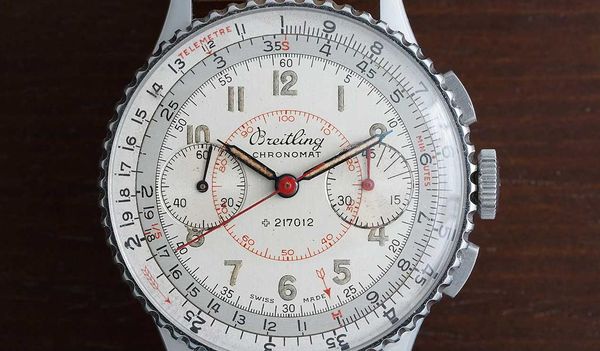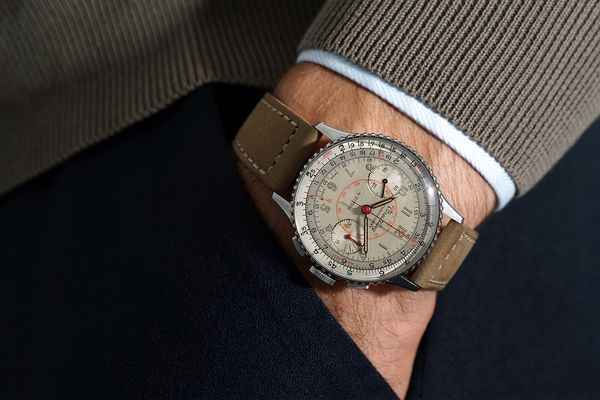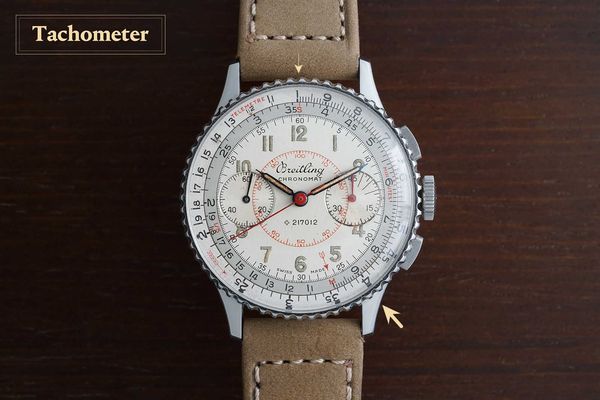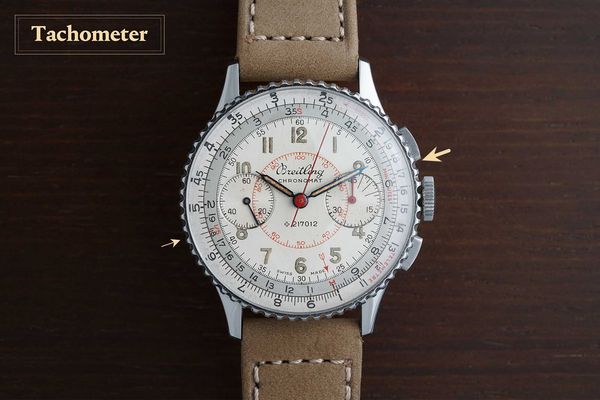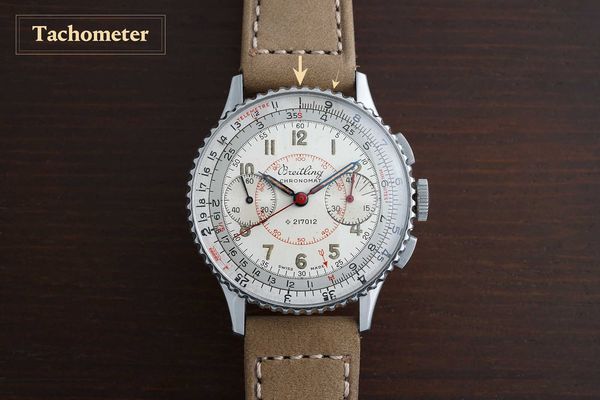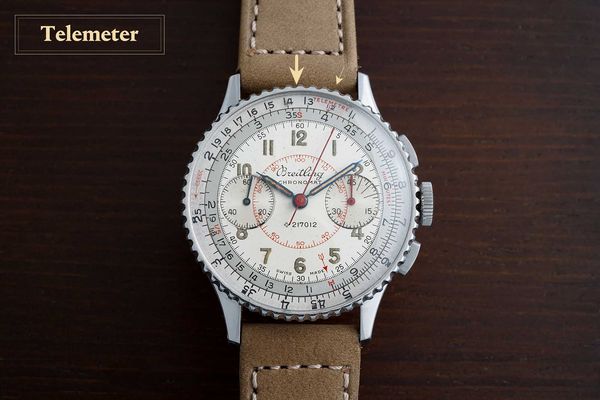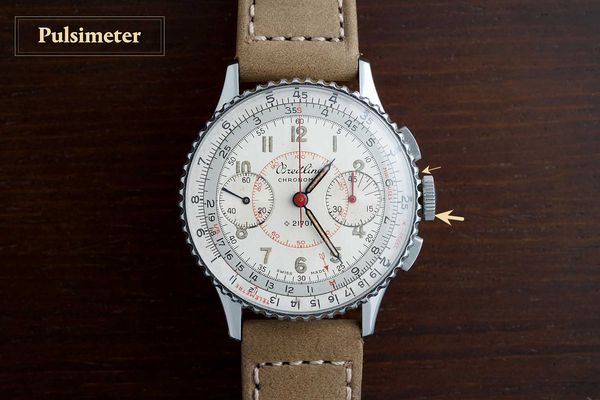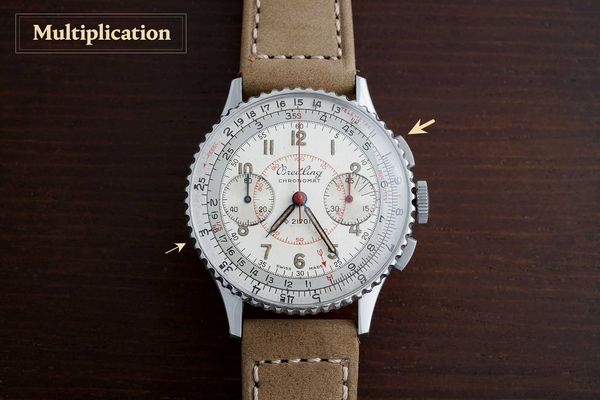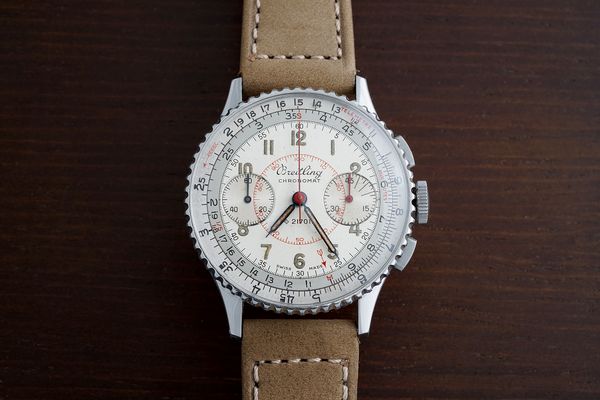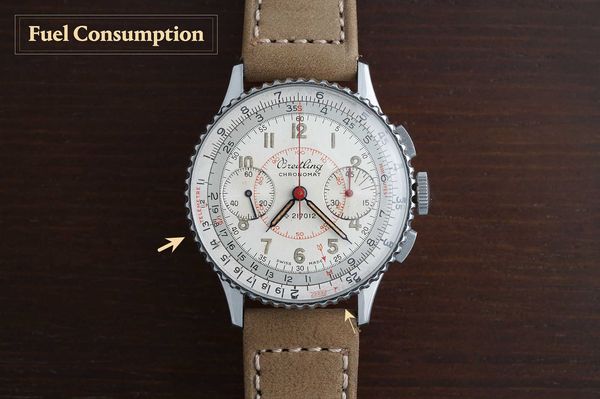The launch of the Breilting Chronomat was one of the defining moments in Breitling’s history. Revealed to the world in 1942, the Chronomat was the first wristwatch to integrate the brand’s patent number 217012, which granted protection for a rotating bezel containing a slide rule – a feature that would later inspire the Navitimer, the manufacturer’s best known pilot’s watch, and one of the most iconic timepieces from the second half of the 20th century.
Almost 80 years later, the slide rule remains a core feature in Breilting's collection, and one of the most fun, but complicated to use. So, when Phillips received an exceptionally well-presered Chronomat for The Geneva Watch Auction: X (Lot 250), we decided to team up with Breitling, who produced an old manual explaining its then brand new invention, with problems and solutions to help users become familiar with the slide rule. We took our watch and re-created those problems.
Tachometer:
How to use it: The time of a chronographic observation is obtained by starting and stopping the large stopwatch seconds hand by means of the upper knob. That time is then converted into 1/5th seconds, minutes or hours, in accordance with the mark chosen and used as unit for the calculation.
Speed:
Lot 250 of The Geneva Watch Auction X, a very well-preserved Breilting Chronomat, circa 1946
Problem: A motorcar runs 1km in 40 sec. What is its speed in km per hour?
Solution: (the distance traversed) is set opposite the mark S (since the chronograph records the time in seconds). 4 (40 seconds duration of running) coincides with 9. Result: 90 km per hour.
Problem 2: A skier makes a jump of 55 metres in 3 2/5 seconds. What is his speed per hour during the jump?
Solution: Set 55 (length of jump) opposite the mark 1/5 (1/5th = time unit). 3 2/5 sec = 17 fifths of a sec. 17 and 58 coincide, giving the result 58km per hour.
Distance Covered
Aim: Calculating the length of the track to be estimated when only the speed is known at which the track is covered. It is then sufficient to make the inverse calculation to the foregoing.
Problem: A motorcar runs for 40 seconds at a speed of 90km per hour. What distance does it cover? (Example No. 1, page 6, in the inverse sense)
Solution: Set 90 (speed) to coincide with 40 (time elapsed). Reading at the mark S (the time unit being in seconds) gives the result 1, i.e distance covered = 1km
Telemeter
Aim: Determining the distance between two points connected by light and sound (distance from a flash of lighting, the position of a canon, a ship, etc.). Used by: Military, military and commercial pilots
How it works: By setting the mark “Telemeter” (red on the outer scale) opposite the number representing the time noted, read the distance traversed by the sound at the mark S seconds, when the time is noted in seconds).
Problem: A peal of thunder is heard 4 seconds after seeing the lighting. How far away was the lightning?
Solution: Set the mark “telemeter” opposite 4 (4 seconds). At the mark S read 13.3 (0.3 estimated). Distance from the lighting = 1 km and 330 meters
Pulsimeter:
Aim: To quickly calculate the rate per minute of a patient’s pulse. Used by: doctors.
How it works: Opposite the mark “Minutes” (the result is desired in minutes) set the counted number of pulse beats, and read opposite the time of observation (in seconds) the number of pulse beats per minute.
Problem: A doctor counts 27 pulse beats in 24 seconds. What is the rate per minute?
Solution: Set 27 (pulse beats) opposite the mark “Minutes”. The desired result is read opposite 24 (observed time). Result: 67 pulse beats per minute.
Important remark: When counting pulse beats, one is tempted to start counting “1” when depressing the knob of the stop-watch. Remember on the contrary that the watch starts at “0”.
Multiplication:
How it works: Set the multiplicand opposite the multiplier. The result is then read opposite the “1” on either scales.
Example: 3 x 18 = 54
Division:
How it works: Division is the inverse of the previous example. Setting the number “1” of either scale opposite the dividend, a complete division table for the number is obtained the result of dividing by any other number being read opposite the divisor, i.e. each divisor coincides with the result.
Fuel Consumption
Aim: Calculating the fuel consumption of a motorcar per 100 km
Problem : A motorcar uses 23 litres of petrol for a journey of 130 km. What is the fuel consumption per 100 km?
Solution: Set the number of litres (23) opposite the “1+ of either scale and read the required result opposite the number representing the distance run by the car, i.e. a consumption of 18 litres per 100 km.
Phillips in Association with Bacs & Russo would like to thank the Breilting Heritage Department for its invaluable help while researching this Chronomat. For more information on our Breitling Chronomat Ref. 769, please see Lot 250 of The Geneva Watch Auction X.
